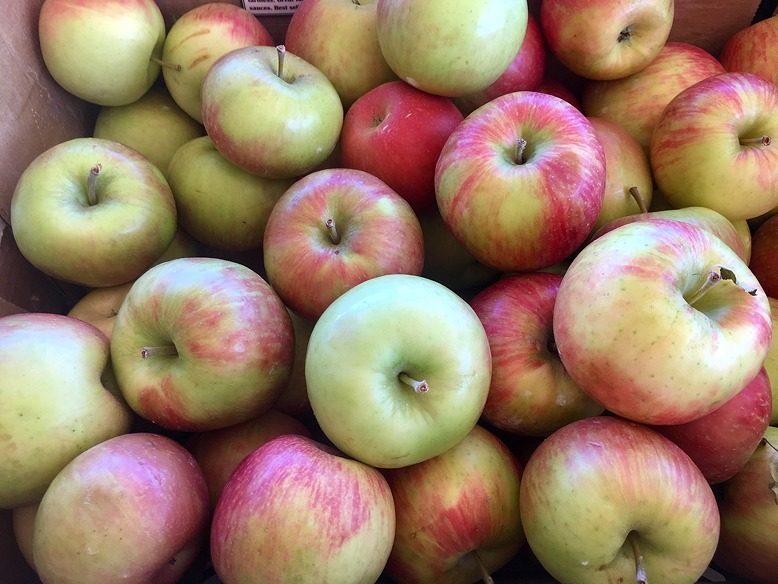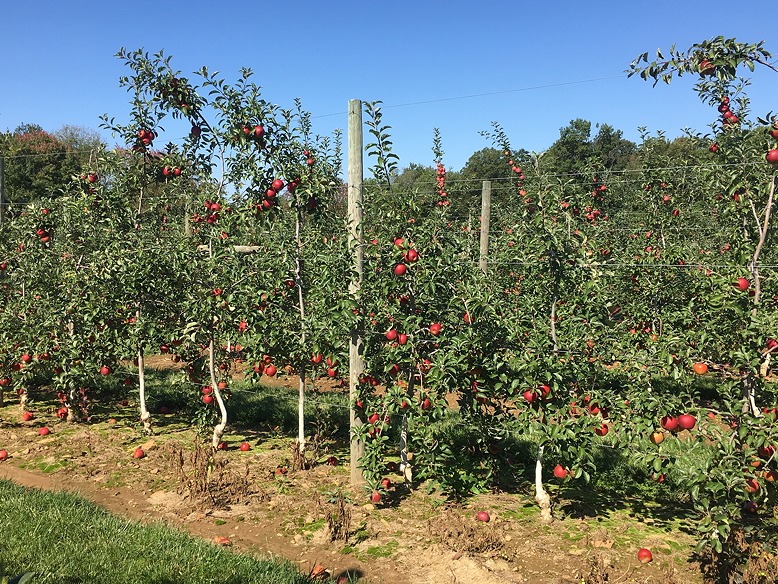
Many people will remember apple orchards from years ago, which typically featured apple trees that could be 30 to 40 feet high and just as wide. When you wanted to go apple picking, you needed a long apple-picking pole with a cup on the end or a tall ladder to get to apples that were up high, and you took your chances climbing the tree, dealing with broken branches, and trying to avoid falling and breaking something else.
Times have definitely changed. Where it used to take an apple tree grown from a seedling to a height of 12 to 20 feet about 6 to 10 years to bear fruit, farmers now have the ability to grow dwarf apple trees from rootstock, which enables farmers and consumers alike to enjoy many benefits. Among those, trees are much shorter and easier for apple pickers to access, farmers can grow trees closer together, increasing their yield per acre, and the trees bear fruit much sooner.
Farmer/owner Dale Davis of Chester-based Stony Hill Farms, which grows 12 acres of apples across three locations, confirmed that orchards have evolved in a positive way. After first planting “French axe” dwarf apple trees on their farm in 1999, “we moved to planting ‘Tall Spindle’ (also known as ‘Slender Spindle’) apple trees in 2006-2007,” Davis said. “These varieties grow to about 12 feet in height and have less complex branches that require less pruning, so while the trees themselves are more expensive, the labor costs associated with pruning and maintaining them is less.” And where it used to take 10 years for traditional apple trees to bear fruit, he said, “Tall Spindle orchards bear fruit by the third year and are fully cropped by the fifth or sixth year, so they return revenue much sooner.”
Apple varieties have changed over the years, too. I’ll never forget an apple variety that we used to sell bushels and bushels of at our family-run business, Napolitano’s Produce in Bergenfield, in the 1950s and 1960s. It was called the ‘Opalescent’ and it was great for pies, eating, applesauce, etc.—that one apple could be used for everything. But you can’t even find an Opalescent anymore; after some varieties grow for years and years, they start to get less productive and less resistant to pests. At that point, farmers end up replacing those trees with newer, stronger, and trendier or more popular varieties.
An Apple a Day
While a lot of apples are shipped to us from Washington State, Oregon, and Australia year-round, local/Northeast apples grow well in the cool fall climates of New Jersey, New York, and the New England states from September through November. Some excellent local varieties include:
Honeycrisp: First introduced in Minnesota in 1991, these apples are honey-sweet with a touch of tart and are amazingly crisp. Because they’re one of the most popular varieties consumed today, more Honeycrisp trees are being planted every year.
Cortland: With their medium-tart to sweet flavor which sweetens further when they’re cooked, many people feel that Cortlands make the best apple pies. They’re particularly good in salads because they’re less apt to getting discolored after being cut.
Winesap: One of America’s oldest varieties, the Winesap is a terrific all-around eating apple; it’s hard and juicy, with a very crisp texture and a tart, wine-like taste. Usually picked after the first frost, they’re still fresh from November through mid-December.
Empire: First introduced in 1966, Empire apples are a cross between a Red Delicious and a Macintosh. They have a sweet-tart taste and are officially my favorite apple.
Macoun:A staple of Northeast apples, Macouns were first developed at the New York State Agricultural Experiment Station in Geneva in 1932 and are named after a famous Canadian fruit breeder. These sweet-tasting apples will only remain crisp and crunchy for a short time, so plan to enjoy them in October–November.
Golden Delicious: Despite their name and similar shape, Golden Delicious apples are completely different from Red Delicious. Don’t be afraid to buy Golden Delicious apples later in the season and/or after a frost; they’re actually a lot sweeter and much crisper then and they make great pies.
At Stony Hill Farms, Davis confirmed that “our most popular variety sold is Honeycrisp, along with Macoun, Gala, and Fuji apples. There’s some great new varieties too,” he said, “including the ‘Evercrisp’ apple, a cross between Honeycrisp and Fuji, as well as Cameo, Snow Sweet, Wine Crisp, and Crimson Crisp varieties.” With over 30 varieties of apples grown there and at farms throughout the state, there’s something to please every apple enthusiast.
Overall, I love apples and especially Northeast apples at this time of year. They eat the best, but like so many things, timing is everything. For example, a Macoun apple in October is crisp and sweet, but by January it can be mealy. Once the weather starts to warm up next year, seek out apples from Washington and Oregon, but until then, get your fill of Northeast apples now and be sure to call ahead to your local farm to see which apples are available for sale/picking and are at their best.
Nothing symbolizes the taste of fall more than apples in October and to me, no apples taste fresher or more crisp than Northeast apples. So enjoy every bite—you know what they say about an apple a day!
About “Produce Pete” Napolitano
With over 65 years of experience in the produce industry, New Jersey’s own “Produce Pete” Napolitano is a renowned fruit and vegetable expert, author, and television personality who’s appeared on a highly-popular segment on NBC’s Weekend Today in New York broadcast every Saturday mornings for over 27 years. For more information, visit Pete’s website.
About Susan Bloom
A contributor to New Jersey Monthly and a variety of other well-known local and national publications, Susan Bloom is an award-winning New Jersey-based freelance writer who covers topics ranging from health and lifestyle to business, food and more. She’s collaborated with Produce Pete on a broad range of articles for nearly a decade.



